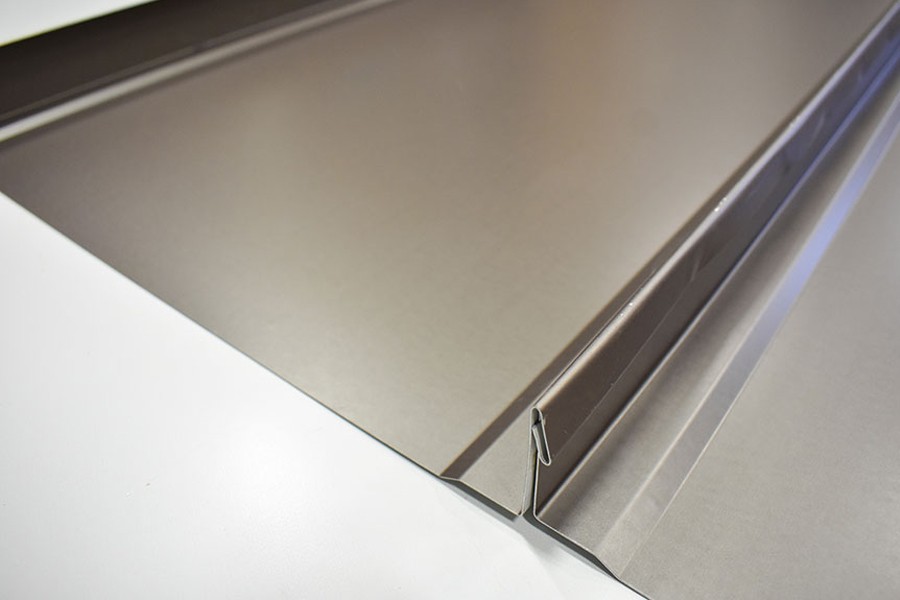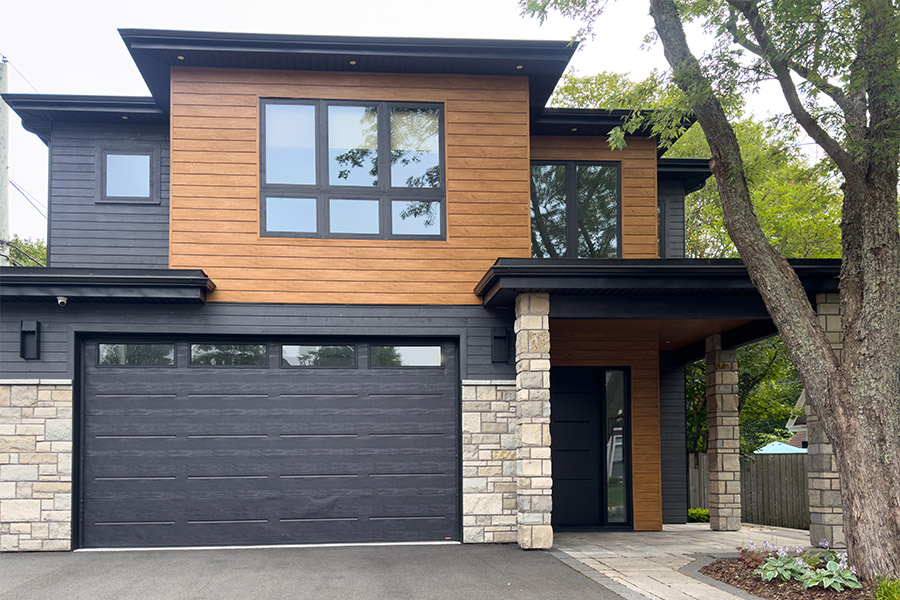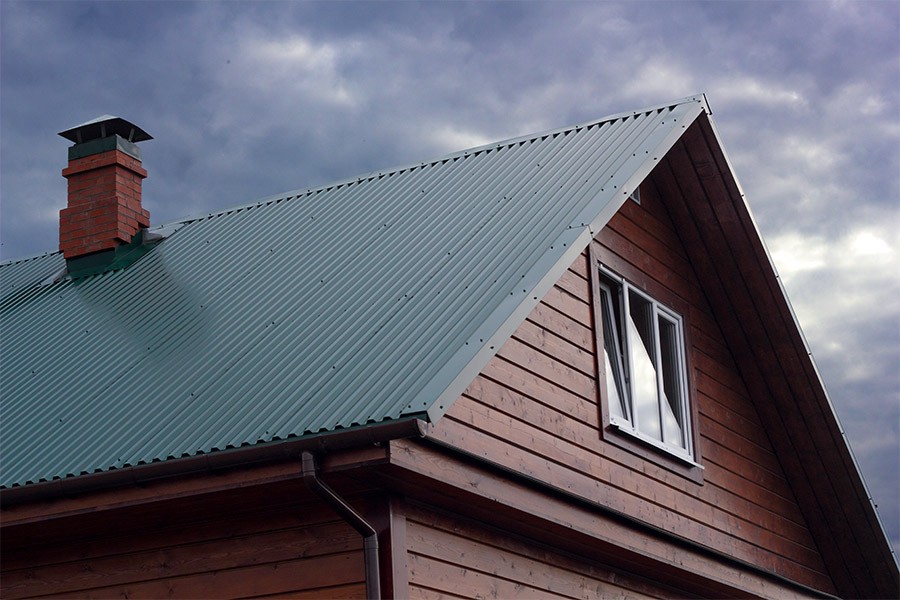Mechanical Lock Panel Systems
Mechanical lock panel systems are standing seam panels known for their rugged feel and use in industrial and commercial buildings. They’ve been standard in the metal roofing and siding industry for years, well-liked for their durability and variety of applications. Mechanical lock panels have a mechanically locked seam, meaning the panel’s edges have vertical legs that line up. The male leg goes down, then a clip is placed over that leg and fastened down. To conceal the clip, the female leg of the panel is placed over the clip.
The two types of mechanical seams used on these types of roofs are single lock or double lock. Single lock seams only have one fold of the seam, which does well for buildings in mild environments. This type of seam is easier to install and fix if damage occurs. Double lock seams have been folded over twice, and they are much stronger than single lock seams. They are excellent for cold-weather environments. While they can be difficult to install and replace, we highly recommended these panels for our region.
Mechanical Lock Panels in Montana Roofing
The ruggedness of this panel makes it a great fit for Montana. Some of these panels are structural and not common residential panels, even though they have recently been used in a lot of the long, low-sloped homes on the market. It’s more of an industrial panel used for commercial and industrial buildings. We generally try to steer Bozeman roofing companies working on residential projects away from this type of panel because of its industrial use and feel. If it is placed on a residential roof, its naturally rugged and rigid look can dwarf the natural aesthetic of the home. This is not our first choice as an accent panel, so if you are looking for a panel to complement or set off the look of a residential home, our team can make insightful recommendations.
Panel Difficulty
On a scale from one to five with five being the most difficult, the mechanical lock panel system is a definite five. Designed for challenging architectural projects, mechanical lock panels are built for performance. They take extensive labor to install, especially since you will need a seamer for these types of panels. Additionally, if you are inexperienced using a seaming device or it is out of adjustment, you can damage the seam or the panel itself. Before choosing mechanical lock panels for a project, ensure you or your team have the training necessary to install this type of panel.
Seamer Rental
Remember, if you choose a mechanical lock panel for a roofing project, you will need to rent a mechanical lock seamer. At Great Northern Metal, we don’t have seamers to rent out, but we have partnered with D.I. Roof Seamers for your seamer rental needs. To rent a seamer through D.I. Roof Seamers, click here.
Mechanical Lock Pros
- Can be used on low-slope roofs
- Choice of varying seam heights
- Strong, long-lasting profile
Mechanical Lock Cons
- Labor-intensive
- Seaming/Unseaming panels risks
- Costly
Types of Mechanical Lock Panels
Below, we’ll review the different types of mechanical lock panels offered at Great Northern Metal Company. Remember: the information we’re providing is specific to Great Northern Metal’s mechanical lock panels. There are other mechanical lock panel manufacturers on the market, and each panel profile is different, depending on the manufacturer.
1” Mechanical Lock
Specifics
Fastener: Concealed
Panel Type: Standing Seam
Panel Seam: Mechanical
Panel Width: 17” or 13”
Seam Height: 1.0”
Panel Material: 22 GA – 26GA Min
Panel Surface: Striated or Flat
Minimum Slope: 3/12
Notes: This panel uses a 20” or 16” coil with a maximum width coil of 20”. This panel uses 3” of material to form the legs of the panel.
Pros
- Excellent vertical rib strength
- Great for low slope roofing
- Suitable for zinc and copper
Cons
- Not suitable for siding, interior, or soffit
Our Insight
Out of the three types of mechanical lock panels listed here, we favor the 1” the most, and we produce more of it at Great Northern Metal than any of the other types of panels. Interestingly, we’ve noticed the industry standard for this panel isn’t what it’s being used for. It also isn’t being used for what we, as metal roofing experts, think it could be used for. We’ve found that architects are super into the long run/low slope roof pitches that have 40-foot long panels. However, in an environment like Montana’s, the only type of panel deemed “acceptable” for this kind of roof is a 2” mechanical lock panel. The downside to the 2” panel is that ice will literally fold the leg over and lay the leg down if it’s too powerful. The 1” inch leg, being double seamed, is stronger vertically than the 2” tall rib. Some people say to not use a 1” mechanical lock on these low-sloped roofs—use a 2” mechanical lock. However, we’ve found that this actually makes the roof look worse, so people have started using the 1”, which has a stronger vertical rib so the ice does not lay it over sideways.
1.5” Mechanical Lock
Specifics
Fastener: Concealed
Panel Type: Standing Seam
Panel Seam: Mechanical
Panel Width: 16” or 12”
Seam Height: 1.5”
Panel Material: 22 GA – 26 GA MIn, .032 – .40
Panel Surface: Flat or Striated
Minimum Slope: 2/12
Notes: With this panel engineering, you may opt to use heavier gauge coil and narrower width panels, and the clip spacing will not change. For slopes lower than a 2/12 roof pitch, contact SMI Technical Department for further installation direction and requirements. This panel uses a 20” coil or a 16” and has a maximum width coil of 20”.
Pros
- Versatile
- Great for a range of environments
- Stronger vertical rib than 2” when double-seamed
Cons
- Not as strong as the 1” mechanical lock rib when double-seamed
- Not suitable for siding, interior, or soffit
Our Insight
This is one of our favorite panels. It’s kind of the middle child, in our opinion, and there are lots of uses for it. It’s good in pretty much any environment, as it’s a very adaptable, forgiving panel. While it’s stronger than the 2” mechanical lock rib vertically when it’s double-seamed, it is not as strong as the 1” mechanical lock with a double-seam. Interestingly, we don’t sell too much of it, as it is mainly specially requested by contractors who are familiar with the panel’s capabilities.
2” Mechanical Lock
Specifics
Fastener: Concealed
Panel Type: Standing Seam
Panel Seam: Mechanical
Panel Width: 18” or 16”
Seam Height: 2”
Panel Material: 22 GA – 24 GA Min, .040
Panel Surface: Flat or Striated
Minimum Slope: .5/12 (Steel) / 2/12 (Aluminum)
Notes: You may opt to use a heavier gauge coil and narrower width panels, but clip spacing will not change. For slopes lower than a 2/12 roof pitch, install sealant per ASTM E 2140.
Pros
- Versatile
- Great for a range of environments
Cons
- Not suitable for siding, interior, or soffit
- Not suitable for homes with varying elevations
- Not suitable for ice/snow buildup
Our Insight
The 2” mechanical lock has a lot of uses. It’s a structural panel, so it’s good for open purlin systems. It’s industry-standard down to the lowest pitch, so it’s excellent for low-slope areas. If you have a roof that has a big, straight run, use the 2” mechanical. Or if you have an open purlin structure, the 2” mechanical can be used too. However, if you have a roof with different elevations on the roof caused by dormers, chimneys, etc., this can cause ice to build up and bend the seam over, so don’t use it.
Consult with Our Metal Experts
If you are considering using mechanical lock panels on your next roofing project, reach out to our team today for an expert’s advice. Our team has decades of combined experience in a wide range of metal roofing systems so that we can provide you with the best options and supplies for your metal roofing and siding needs. To speak to a professional or get a quote, drop us a line or give us a call at (406) 624-0435.


